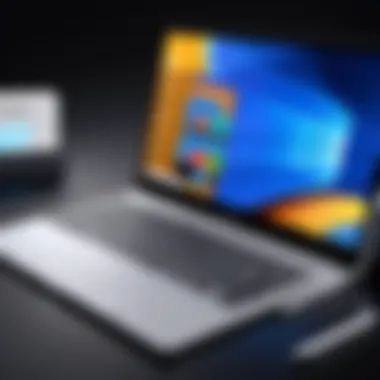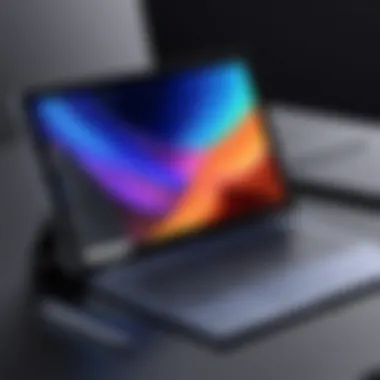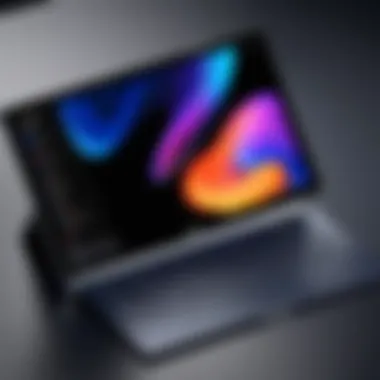In-Depth Pricing Analysis of Samsung Galaxy Book 2


Pricing Analysis of the Samsung Galaxy Book
Intro
The Samsung Galaxy Book 2 enters a competitive technology landscape as more users seek reliable and efficient devices. Assessing its pricing is crucial alongside considering current market trends. This section aims to open a discussion on significant factors impacting the device's cost. Such analysis includes the brand's history, specific capabilities, and the device’s position among peers. Understanding this can aid consumers considering investments in this product.
Product Overview
Brand Information
Samsung is a leading player in global technology, synonymous with innovation. The Galaxy Book series seeks to bridge the gap between ultra-portable devices and high-end performance. They offer comprehensive solutions for both personal and business needs. The Galaxy Book 2 continues this tradition, integrating formidable specs coupled with sleek design and mature software integration.
Key Specifications
The Samsung Galaxy Book 2 excels in multiple areas. An intelligent balance between performance and portability defines its outlook. Key specifications of this model include:
- Display: 13.3-inch FHD AMOLED 1920 x 1080 resolution
- Processor: 12th Gen Intel Core i5/i7
- RAM: 8GB or 16GB LPDDR4x
- Storage: Options for 256GB to 1TB SSD
- Operating System: Windows 11
- Battery Life: Up to 10 hours
Pricing
Initially priced at around $999 for the base configuration, it can reach above $1,200 for top specs. Variations arise based on RAM, storage options, and even color choice. It’s pivotal to constantly track fluctuations as market strategies evolve.
Performance Comparison
Benchmark Tests
Benchmarks serve as essential tools for assessing device capabilities. The Galaxy Book 2 performs favorably against similar offerings. Despite various task demands, it holds well during multi-threaded applications. Users appreciate its responsiveness mainly for office applications or light software development tasks.
Speed and Efficiency Comparisons
In terms of speed, reviews widely highlight the Galaxy Book 2's seamless user experience. Compared to peers like the XPS 13 or MacBook Air, users note it excels in application launching and switching. The efficiency in battery cycles ensures uninterrupted usage, making it preferable for commuting professionals.
Features and Technology
Unique Features
Samsung incorporated various user-friendly features in the Galaxy Book 2. Its device functionality aligns well, offering:
- S Pen Support for quick note-taking
- Four surround speakers with AKG optimization
- Fingerprint Reader for security
These add-ons contribute to everyday utility, especially in pressures of face-paced environments.
Technological Advancements
Adopting cutting-edge technologies builds its strong positioning. With Windows 11 integration, it includes enhanced virtual desktops and touch Features. Compatibility with other Samsung Galaxy devices affords users a logical ecosystem, beneficial for those already owned arrayed devices.
Pros and Cons
Strengths of the Product
Notable strengths of the Galaxy Book 2 reside in its:
- Robust Build Quality
- Impressive Display Attributes for visual tasks
- Broad Range of Hardware Options for customization
Areas for Improvement
Still, some weaknesses become apparent:


- The price point could be considered steep in entry configurations.
- Regular upgrades can render early models obsolete too quickly.
Value for Money
Cost-effectiveness
The Samsung Galaxy Book 2 delivers promising performances for various use cases. Its positioning maintains a delicate balance of price to specification ratio. Results showcase its suit to both standard working professionals and casual tech enthusiasts.
Long-term Benefits
Investing in this device improves the potential return seen in reliable performance over time. Customers appreciate not needing to replace devices frequently, aligning value with high quality.
Comparison With Similar Products
Possible competitors include the Lenovo Yoga 7i or Microsoft Surface Laptop 4. However, Galaxy Book 2 typically offers better display quality without excessive calorie consumption for enhanced battery life.
An informed purchase requires dissecting technical specifications bundled with strategic pricing.
Understanding the Samsung Galaxy Book
The Samsung Galaxy Book 2 offers a range of features that align with the needs of modern users. Its design (acorifestyles) cater to those who prioritize portability alongside performance. As an intricate blend of powerful hardware and sleek aesthetics, the Galaxy Book 2 exemplifies Samsung's commitment to innovation. Grasping the essence of this device allows potential buyers to weigh their options effectively when purchasing.
Overview of the Device
The Galaxy Book 2, developed by Samsung, serves as a versatile device that accommodates various user requirements. It becomes essential for users to understand specific aspects such as build quality and functional design. This model provides efficient processing power, along with a clear display and ample connectivity options. These elements summarize not just the device itself but the overall experience it offers. Knowing the unique features helps buyers gauge if it meets their specific needs and preferences.
Key Specifications
Understanding key specifications is crucial when analyzing the Galaxy Book 2. These specifications often influence a user's purchasing decision, highlighting why certain models appeal over others. Below are Vital components that define the Galaxy Book 2's performance and capability.
Processor Options
The Galaxy Book 2 brings notable processor options, including Intel chipsets from the Core i5 and i7 families. This selection ensures strong multitasking and smoother experiences across various tasks. Users benefitting from the i7 will notice enhanced speed, notably during computationally demanding tasks like rendering or heavy multitasking. There is a clear advantage with these choices; choosing an i7 over an i5 could dramatically impact the efficiency of intensive applications.
Display Characteristics
Another consideration when examining the Galaxy Book 2 is the display characteristics. The device features a Super AMOLED display that supports high-definition resolution. This results in vivid colors and deeper blacks, which enhances the visual experience. However, while the color accuracy presents several advantages, some users may identify brightness levels as insufficient in direct light conditions. Overall, the display's quality becomes an important factor for users who consume media regularly, providing a better experience when compared to standard screens.
RAM and Storage Configurations
RAM and storage configurations are significant attributes influencing the overall usability of the Galaxy Book 2. Users can opt for options ranging from 8GB to 16GB of RAM, with storage options typically spanning from 128GB to 512GB SSDs. Selecting a high RAM option is particularly advantageous for users who perform multiple operations in tandem. However, storage capacity can limit how much data can be retained, as expansions on cloud or external drives may need to be considered. This is particularly relevant for users who require more space for applications or files.
Battery Life and Performance
Examining battery life and performance is crucial for any portable device. The Galaxy Book 2 boasts an impressive battery lasting up to 20 hours on moderate usage. This extent renders it suitable for long working sessions without disruption. While the claim benchmarks well, real-life performance may vary based on individual use scenarios. It's essential for users to recognize that intensive workloads might drain battery much faster.
Pricing Structure of Samsung Galaxy Book
Understanding the pricing structure of the Samsung Galaxy Book 2 is crucial for both potential buyers and tech enthusiasts. This section delves into the various components that create its price point. An in-depth insight into its pricing can provide significant value for anyone considering this device, especially when comparing its offerings with competitors in the market.
The pricing structure is not merely a function of cost; it embodies the perceived value, feature set, and overall brand positioning in the industry. Grasping this structure will help consumers navigate through the implications of choosing different variants while keeping in mind their budgetary limitations and needs.
Base Model Pricing
The base model pricing of the Samsung Galaxy Book 2 serves as the foundation of its overall cost structure. It is critical to understand what is included in this base model, as it represents the entry point for new customers into the Samsung ecosystem. Typically, this model includes standard RAM and storage options, a sleek design, and sufficient processing power for everyday tasks.
As of October 2023, the base model of the Samsung Galaxy Book 2 is priced competitively within the market for similar laptops. The current base price positions it as an appealing choice for both students and professionals who seek a balance of performance and cost. Recognizing what the base model offers is essential for potential buyers, as it reflects Samsung's commitment to providing quality without overinflating costs.
Evaluation of this model’s specifications, alongside the price, fosters better understanding among users on what gives real value to their purchases, which does mostly encompass:


- Available RAM and storage size
- Processing speed and capability
- Display resolution and quality
Variants and Their Costs
Within the pricing structure of the Samsung Galaxy Book 2, a variety of models cater to different user needs and preferences, each presenting its unique pricing. These variants generally reflect differences in component quality, configuration, and additional feature sets.
The advanced options will typically feature increased RAM or storage capacity, superior display characteristics, and possible upgrades in processing units, such as moving from an Intel Core i5 to an Intel Core i7. Additionally, each configuration impacts the total price profoundly, creating a tiered pricing effect in Samsung's offering. Below is a brief overview of some observed variance:
- Higher RAM Models: This variant of the Samsung Galaxy Book 2 is geared towards professionals working with multitasking applications. Higher RAM prices can reach a notable premium.
- Storage Options: Models with extra storage or faster SSDs also come with additional costs. Users must weigh the necessity of these upgrades versus their budgets.
- Performance Upgraded Models: The cost increasingly juxtaposes quality and efficiency, especially for serious gamers or anyone engaging in intensive software.
Factors Affecting Pricing
Pricing is not just a number. It reflects a confluence of various elements that influence purchasing decisions. Understanding the aspects that determine the price of the Samsung Galaxy Book 2 provides valuable insight into its position in the market. These include component quality, brand value, market positioning, and global supply chain factors. Each plays a critical role in shaping how consumers view this device and what they are willing to invest in it.
Component Quality
The quality of components used in the Galaxy Book 2 significantly influences its pricing. Higher quality materials and parts typically incur a higher cost, which is then passed on to the consumer. For instance:
- Display Technology: The device boasts a high-resolution AMOLED display, which enhances the viewing experience but raises overall manufacturing costs.
- Internal Hardware: Choices related to processing units and graphics cards also contribute to the final price. Options with improved performance lead to increased expenses.
- Build Quality: Robust construction materials not only yield a more durable product but affect the pricing as well.
This aspect is crucial for tech enthusiasts, as they often seek specifications that deliver a tangible performance benefit. Analyzing the expenditures involved in component selections can help contextualize the ultimate price point of the device.
Brand Value
Brand reputation influences pricing substantially. Samsung has a synergistic effect in positioning its products as top-tier options. Consumers often associate the brand with reliability, innovation, and premium experiences. This tradition leads to a tendency to expect higher prices aligned with that perception.
- Market Trust: When consumers see the Samsung logo, a belief in quality often exists, which influences their willingness to pay a premium.
- After-Sales Service: Samsung usually offers robust support which provides reassurance to buyers, contributing to the overall brand value in a competitive tech market.
A comprehensive examination of what Samsung represents can therefore clarify pricing paradoxes when compared to lesser known brands that may present similar specifications.
Market Positioning
Market positioning defines how the Galaxy Book 2 is viewed against competitors. Understanding where this device fits in the larger ecosystem helps delineate pricing decisions. It aims to attract segments preferring premium offerings despite the presence of budget rivalry.
- Target Audience: High-end laptops often cater to professionals who prioritize portability coupled with performance, and Samsung positions its device accordingly.
- Competitor Analysis: A comparative study can offer insights into why Samsung set prices at certain levels and how it varies from products such as the Dell XPS Series or HP Spectre x360.
- Unique Selling Points: Emphasizing standout features fosters an advantage that can justify higher pricing structures.
This positioning explicates the reasons consumers might choose this product over cheaper alternatives. The perceived value blended with performance paves the road for serious consideration.
Global Supply Chain Factors
In the digital age, understanding global supply chain dynamics is essential. The Galaxy Book 2 cannot escape realities like dispatch delays or market fluctuations of essential components, especially given current economic conditions. This includes:
- Component Costs: Sometimes semiconductor shortages or logistic hurdles impact the costs directly associated with building high-end laptops.
- Economic Factors: Fluctuations in currency exchange rates can affect price benchmarks globally, pushing manufacturers to reconsider pricing strategies inneccessarily.
- Geopolitical Trends: Trade policies and tariffs could impose additional financial pressures on manufacturers, eventually filtering through to consumers.
Understanding this intricate web of influences offers a well-rounded perspective on the Galaxy Book 2’s pricing strategy. These factors intertwine to affect consumer purchasing power, rendering the device not only a technology investment but also a reflection of broader economic climates.
Comparative Pricing Analysis
The comparative pricing analysis is a vital component of this article, as it offers insights into how the Samsung Galaxy Book 2 stands against its main competitors in the market. By analyzing competitor products, we can better understand the Galaxy Book 2's positioning in terms of features, pricing, and value for money. Understanding this comparative framework helps consumers make informed decisions when considering their laptop options. Several elements such as performance, design, and price points play an important role in shaping the consumer's buying journey.
Competitor Products
Dell XPS Series
The Dell XPS Series is widely known for its premium build quality and performance. One notable feature is the InfinityEdge display, offering nearly borderless visuals that enhance viewing experiences. This standout characteristic makes Dell XPS a preferred choice for professionals and content creators alike. The XPS Series machines often include options like high-end graphics cards and powerful processors, making them potent tools for demanding applications. However, this superior hardware comes at a steep price, which can deter budget-conscious buyers.
HP Spectre x360
The HP Spectre x360 stands out with its convertible form factor, known for its versatility. Users often find the touchscreen and 360-degree hinge appealing, making it suitable for both entertainment and productivity tasks. A significant offering is the sleek design, which not only looks elegant but is also made with premium materials. Nevertheless, while many users celebrate its aesthetic and functional flexibility, performance may lag behind laptops optimized for gaming or heavy workloads, which limits its market appeal in those areas.


Microsoft Surface Laptop
Microsoft Surface Laptop is renowned for its sleek and minimalist design, complemented by a PixelSense display. This device prioritizes user experience and often has a top-tier keyboard, appealing to anyone who spends long periods typing. It is considered a great fit for students and casual users due to its balance of features and affordability. However, its limited ports and non-upgradable RAM can constrain certain users, potentially complicating decisions for tech-savvy shoppers looking for longevity and expansion.
Price-Performance Ratio
A deeper analysis of the price-performance ratio enhances our overall understanding of the Samsung Galaxy Book 2. When looking into different models, we must evaluate whether consumers get enough value relative to the price they pay. In addition, aspects such as system performance, build quality, and support are essential in judging the hardware’s worth. Throughout this evaluation of alternatives, clarity on how these models stack up helps prospective buyers discern which best suits their preferences and requirements. By examining various devices, the distinction regarding what constitutes value is further elucidated.
Market Trends Influencing Price
Market trends are core factors in determining pricing. Trends create a dynamic environment in which manufacturers, retailers, and customers interact. Understanding them is essential for evaluating the pricing of the Samsung Galaxy Book 2.
Technological Advancements
Technological advancements play a significant role. When new technology emerges, the pricing dynamics shift. For example, advancements in processors and graphics capabilities often lead to higher costs. Yet, they also encourage consumers to pay a premium for upgraded features. For the Samsung Galaxy Book 2, its specifications leverage current technology trends, making it competitive in an ever-evolving market. Emerging technologies like OLED displays and AI capabilities can dictate pricing strategies, resulting in variations dependent on the integration of such features.
Consumer Demand Patterns
Consumer demand greatly influences pricing trends. Fluctuations in demand can affect how a brand prices its products. Economic conditions, changing user preferences, and seasonal trends contribute to this. If a significant number of consumers are seeking lightweight and portable devices, manufacturers must adjust prices accordingly. This is evident in periods like launch events or back-to-school seasons.
The intersection of technology and market demand distinguishes competitive pricing strategies.
User Perspectives on Pricing
Understanding user perspectives on pricing is vital for evaluating any device, including the Samsung Galaxy Book 2. These viewpoints contribute significantly to the overall perception of value, affordability, and market positioning. By capturing user sentiments, one can discern whether consumers feel the product lives up to its price point. This section delves into two core aspects: Value for Money Opinions and Feedback on Pricing Strategy.
Value for Money Opinions
Customers and potential buyers assess value for money by contrasting features with pricing. Reviews and discussions often focus on tangible characteristics like performance, build quality, and adaptability.
- Performance Expectations: Consumers expect consistent performance that justifies the investment made in the unit. The presence of sufficient RAM and a powerful processor influences these perceptions greatly.
- Comparison with Alternatives: Users frequently benchmark the Samsung Galaxy Book 2 against competitors, considering devices such as the Dell XPS Series and Microsoft Surface Laptop. These comparative analyses inform whether they believe they are getting a reasonable deal.
User opinions about worthwhile purchases offer crucial insights that are instrumental for both future buyers and Samsung's pricing strategy. If many consider the Galaxy Book 2 to be overpriced, it suggests a need for reevaluation.
Feedback on Pricing Strategy
Feedback regarding pricing strategy reveals how well the brand aligns with user expectations. A primary consideration is how Samsung communicates its pricing model and the rationale behind it. This layer of information can ultimately streamline customer satisfaction.
- Transparency in Pricing: Clear price breakdowns can alleviate concerns, portraying the brand as reliable. When users recognize the factors contributing to the pricing, such as quality and innovation, their acceptance generally increases.
- Incentives and Promotions: User insights regarding special offers significantly impact perceptions of pricing. For instance, are promotional discounts worth pursuing? Does the brand offer competitive trade-in solutions? Such discussions shed light on economic considerations beyond the sticker price.
In summary, evaluating user perspectives on pricing encompasses several dimensions that enrich understanding. Insights drawn from these opinions not only help individuals make informed purchasing decisions but may also guide Samsung in future pricing strategies, ensuring alignments with market needs and consumer expectations.
The End
In this final section, we reflect on the importance of evaluating the pricing strategy of the Samsung Galaxy Book 2. Understanding the price characteristics serves several purposes for different stakeholders.
First, it provides valuable information for potential consumers. Knowing how the price aligns with the specifications and features helps buyers determine whether it justifies their investment. Value for money becomes a vital aspect of the decision-making process. Moreover, an analysis of pricing in a competitive landscape highlights where the Galaxy Book 2 stands compared to its peers.
Second, from a business standpoint, analyzing the pricing structure can uncover insights about market trends and consumer behaviors. Understanding these factors can inform future product launches and marketing strategies.
Furthermore, comprehending the components that affect the device's cost establishes a link between raw material quality and pricing models established by manufacturers. Examining this can enable more informed discussions about what constitutes fair pricing in the tech market.
A comprehensive pricing evaluation assists tech enthusiasts and professionals in making judicious purchasing decisions and enhances the overall understanding of the device’s place in the market.
The considerations around pricing also encompass budget implications for different users, where many professionals often look for long-term investments rather than short-term expenditures. Thus, a detailed exploration of the Samsung Galaxy Book 2's pricing scenario helps articulate a more informed narrative in terms of the tech market and its pricing dynamics.
Final Thoughts on Price Evaluation
Assessing the price of the Samsung Galaxy Book 2 brings people to several conclusions. It sheds light on competitors, demanding attention on how Samsung positions its product. During the evaluation process, the specifications must be systematically compared against rival manufacturers, including consensus on key features to verify the relevant cost markers. This practice includes weighing the performance and intended usage case often paramount in sizable investments.
Moreover, consumer feedback often shapes perceptions around pricing strategies while ensuring said strategies adapt to market fluctuations with evolving consumer needs. It is critical for both consumers and producers to stay astute within a rapidly changing tech environment. Innovations drive expectations while highlighting pressing inequalities in pricing and their justification, motivating a deeper understanding of manufacturers as they develop new offers.
The narrative around the Galaxy Book 2 fosters an ecosystem that aids informed choices, strategic assessment of features, and embraces the essential dialogue on valuing technology.
While final purchasing decisions often encompass elements far exceeding prices alone, this detailed examination holds importance in sync with individual objectives and tech trends.







